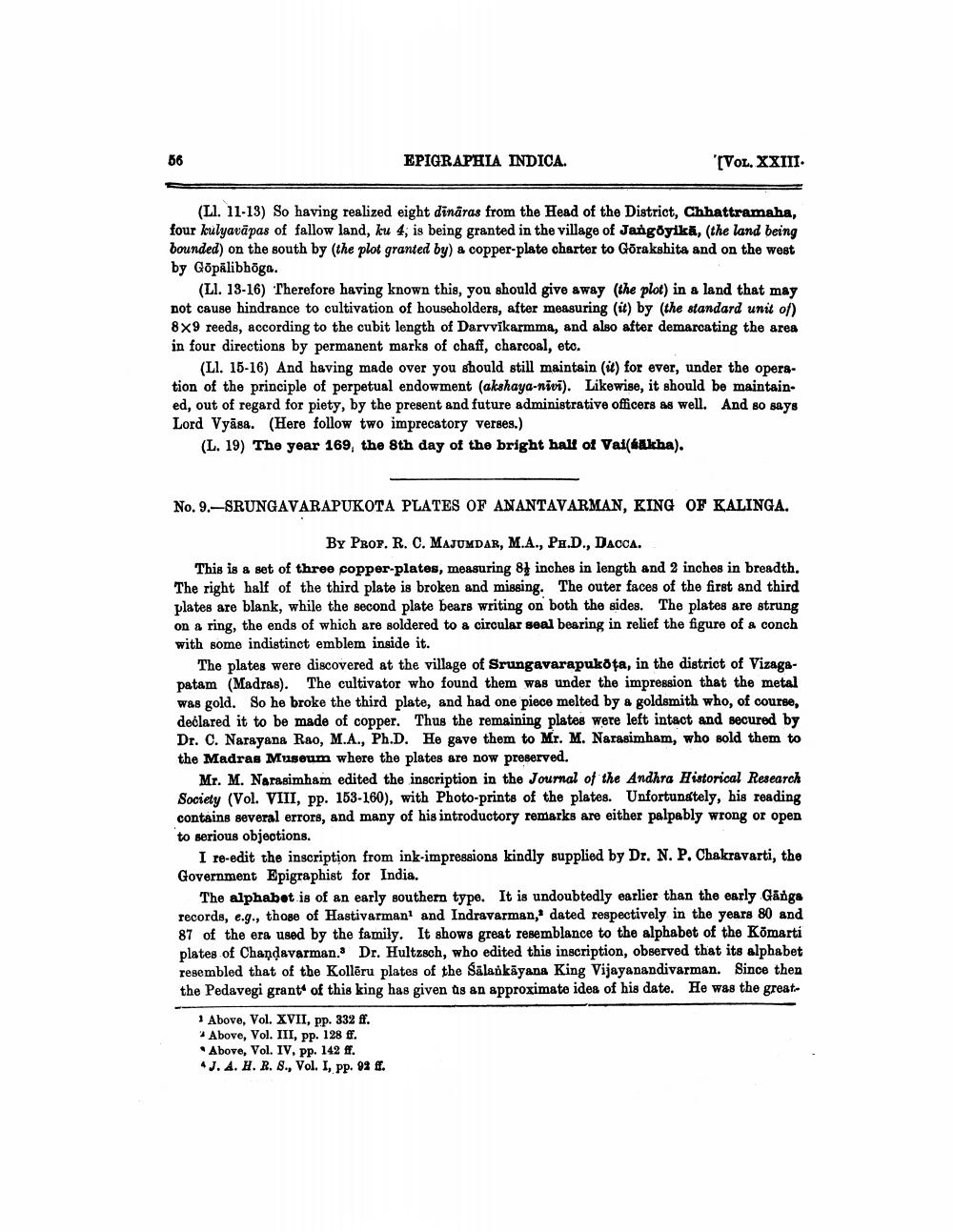________________
EPIGRAPHIA INDICA.
[VOL. XXIII.
(LI. 11-13) So having realized eight dinaras from the Head of the District, Chhattramaha, four kulyavāpas of fallow land, ku 4, is being granted in the village of Jangoyikā, (the land being bounded) on the south by the plot granted by) a copper-plate charter to Gõrakshita and on the west by Gopālibhöga.
(Ll. 13-16) Therefore having known this, you should give away (the plot) in a land that may not cause hindrance to cultivation of householders, after measuring (it) by (the standard unit of) 8X9 reede, according to the cubit length of Darvvikarmma, and also after demarcating the area in four directions by permanent marks of chaff, charcoal, etc.
(Ll. 15-16) And having made over you should still maintain (it) for ever, under the operation of the principle of perpetual endowment (akshaya-nivi). Likewise, it should be maintained, out of regard for piety, by the present and future administrative officers as well. And 80 says Lord Vyāsa. (Here follow two imprecatory verses.)
(L. 19) The year 169, the 8th day of the bright hall of Vallakha).
No. 9.-SRUNGAVARAPUKOTA PLATES OF ANANTAVARMAN, KING OF KALINGA.
BY PROF. R. C. MAJUMDAR, M.A., Ph.D., DACCA. This is a set of three copper-plates, measuring 81 inches in length and 2 inches in breadth. The right half of the third plate is broken and missing. The outer faces of the first and third plates are blank, while the second plate bears writing on both the sides. The plates are strung on & ring, the ends of which are soldered to a circular seal bearing in relief the figure of a conch with some indistinct emblem inside it.
The plates were discovered at the village of Srungavarapukota, in the district of Vizagapatam (Madras). The cultivator who found them was under the impression that the metal was gold. So he broke the third plate, and had one piece melted by a goldsmith who, of course, declared it to be made of copper. Thus the remaining plates were left intact and secured by Dr. C. Narayana Rao, M.A., Ph.D. He gave them to Mr. M. Narasimham, who sold them to the Madras Museum where the plates are now preserved.
Mr. M. Narasimham edited the inscription in the Journal of the Andhra Historical Research Society (Vol. VIII, pp. 153-160), with Photo-prints of the plates. Unfortunately, his reading contains several errors, and many of his introductory remarks are either palpably wrong or open to serious objections.
I re-edit the inscription from ink-impressions kindly supplied by Dr. N. P. Chakravarti, the Government Epigraphist for India.
The alphabet.is of an early southern type. It is undoubtedly earlier than the early Ganga records, e.g., those of Hastivarman' and Indravarman,' dated respectively in the years 80 and 87 of the era used by the family. It shows great resemblance to the alphabet of the Kōmarti plates of Chandavarman. Dr. Hultzsch, who edited this inscription, observed that its alphabet resembled that of the Kollēru plates of the Salankäyana King Vijayanandivarman. Since then the Pedavegi grant of this king has given us an approximate idea of his date. He was the great
1 Above, Vol. XVII, pp. 332 ff.
Above, Vol. III, pp. 128 ff. Above, Vol. IV, pp. 142 ff. * J. A. H. R. 8., Vol. I, pp. 99 ff.




